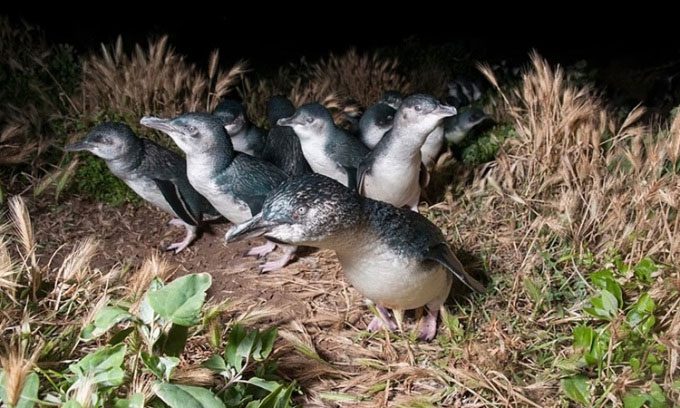The crows are pairing up to attack parent birds while simultaneously digging into nests to steal eggs and chicks, posing a threat to the penguin population on Phillip Island.
On the shallow beaches of Phillip Island in Australia, tiny penguins standing just 30 cm tall and weighing 1.4 kg struggle to protect their young. Their attackers are the crows on the island, according to National Geographic.

Little penguins (Eudyptula minor) returning to their nests on Phillip Island in the evening. (Photo: Tui De Roy)
The crows will spend several days observing the burrow of the little penguins before launching an attack. They operate in pairs, with the larger crow distracting the parent penguin while the smaller one digs into the burrow from above to steal eggs or chicks. In one particularly violent attack, researchers witnessed a pair of crows throwing a parent penguin off a cliff before raiding the burrow. However, typically, the crows will harass the parent penguin for several hours until it loses hope and gives up, according to expert Kasun Ekanayake from BirdLife Australia.
In fact, 20 years ago, the research team discovered that crows from mainland Australia began preying on the larger penguins on the island in the 1970s. Now, as each species develops new tactics to outsmart the other, researchers are urgently seeking ways to prevent the crows’ predatory behavior before it begins to impact the penguin population.
Little penguins inhabit the coastal areas of southern Australia and New Zealand and are not considered endangered. However, with over 40,000 breeding individuals, the population on Phillip Island is among the largest. The island’s ecosystem exists in a delicate balance, and it only takes a small change for that harmony to collapse.
“As far as we know, it seems that other penguin populations are not affected by crow attacks,” said Mike Weston, a professor of wildlife and conservation biology at Deakin University in Melbourne. “This indicates that the local crow population has learned to attack, and there is a risk that this behavior will spread.”
Foxes were once the biggest threat to the Phillip Island penguin population, with over 3,000 birds becoming victims, but authorities’ efforts to eradicate them resulted in the island being free of foxes by 2015. According to Weston, crows are an underestimated natural predator. Their ability to thrive in urban settings, eat a wide variety of flora and fauna, and their high intelligence make them particularly difficult to mitigate. These characteristics also explain why their numbers continue to grow. A 2021 study attributed the predatory behavior of crows to social learning rather than genetics, but much remains unknown to researchers.
In 2013, researchers found that over 60% of the penguin nests they monitored were attacked or destroyed. Just two days later, 30% of the observed nests were attacked, demonstrating that penguins are adapting their nesting behaviors for better safety against crows. As of recently, the penguin population on the island has maintained a stable level since 2015. This is due to the fluctuating rate of crow attacks on penguin nests from year to year, according to researcher Laura Tan from BirdLife Australia, which partially depends on the availability of alternative food sources.
Weston, Tan, and their colleagues are also experimenting to determine whether penguin DNA can be detected in crow feces, helping researchers better understand how prevalent penguin predation is among crows on the island. Although not as useful as hoped, the test results showed that crows consume more birds and mammals than previously anticipated, indicating that the increasing number of crows is a concerning issue not only for penguins but also for other ground-nesting bird species.


















































